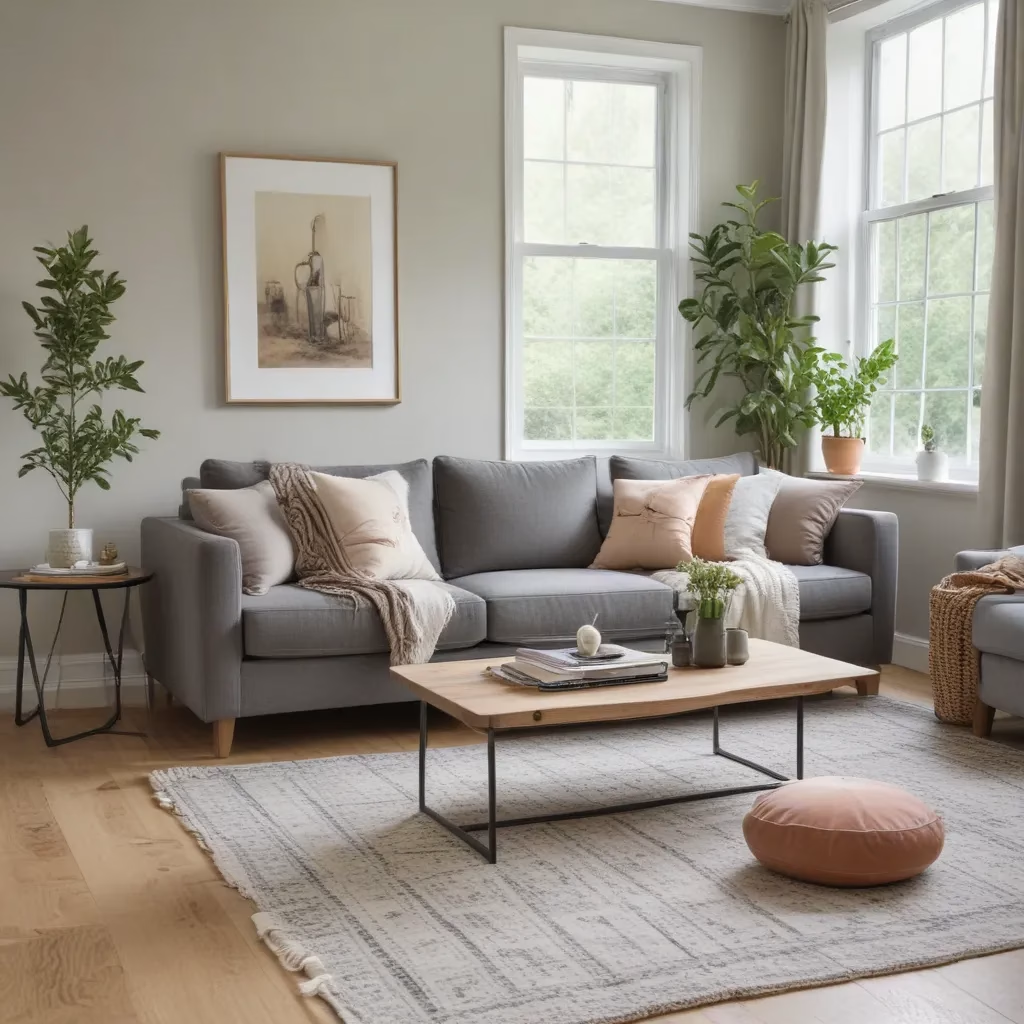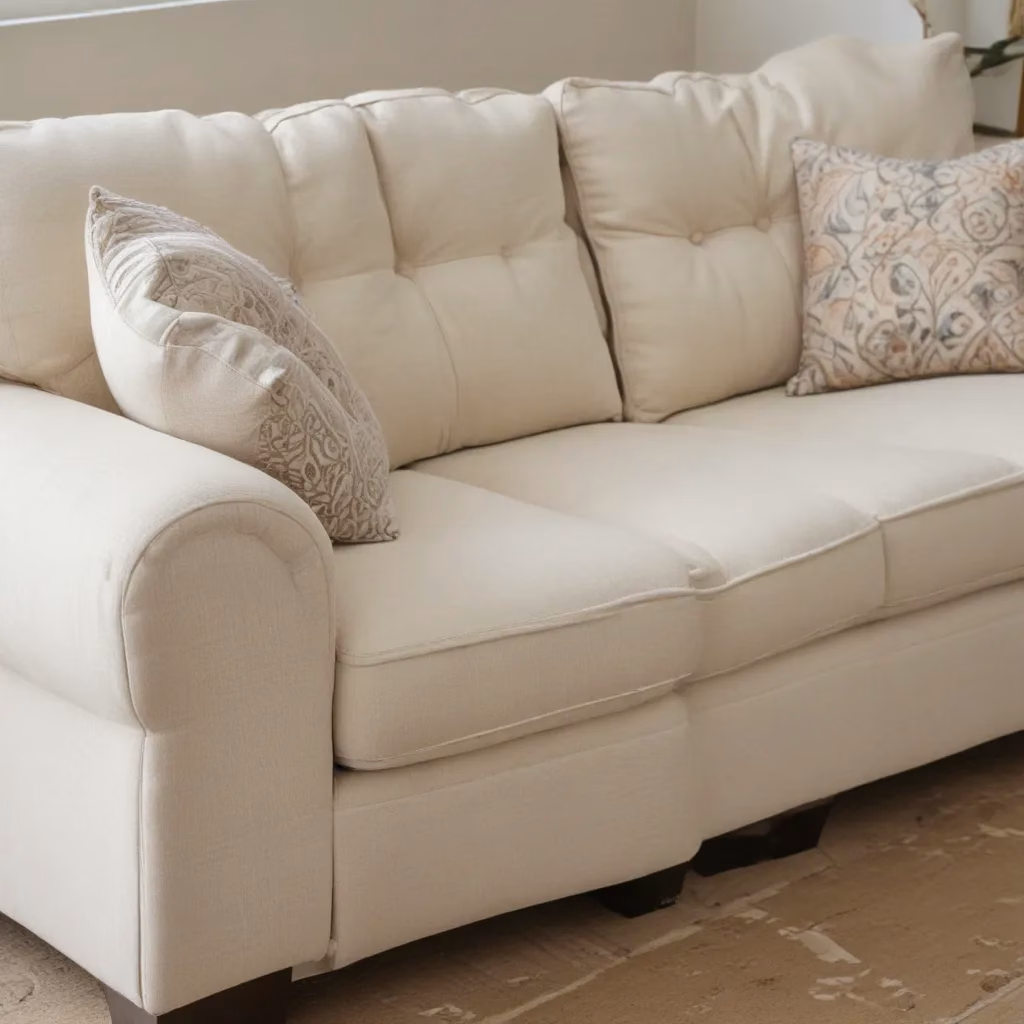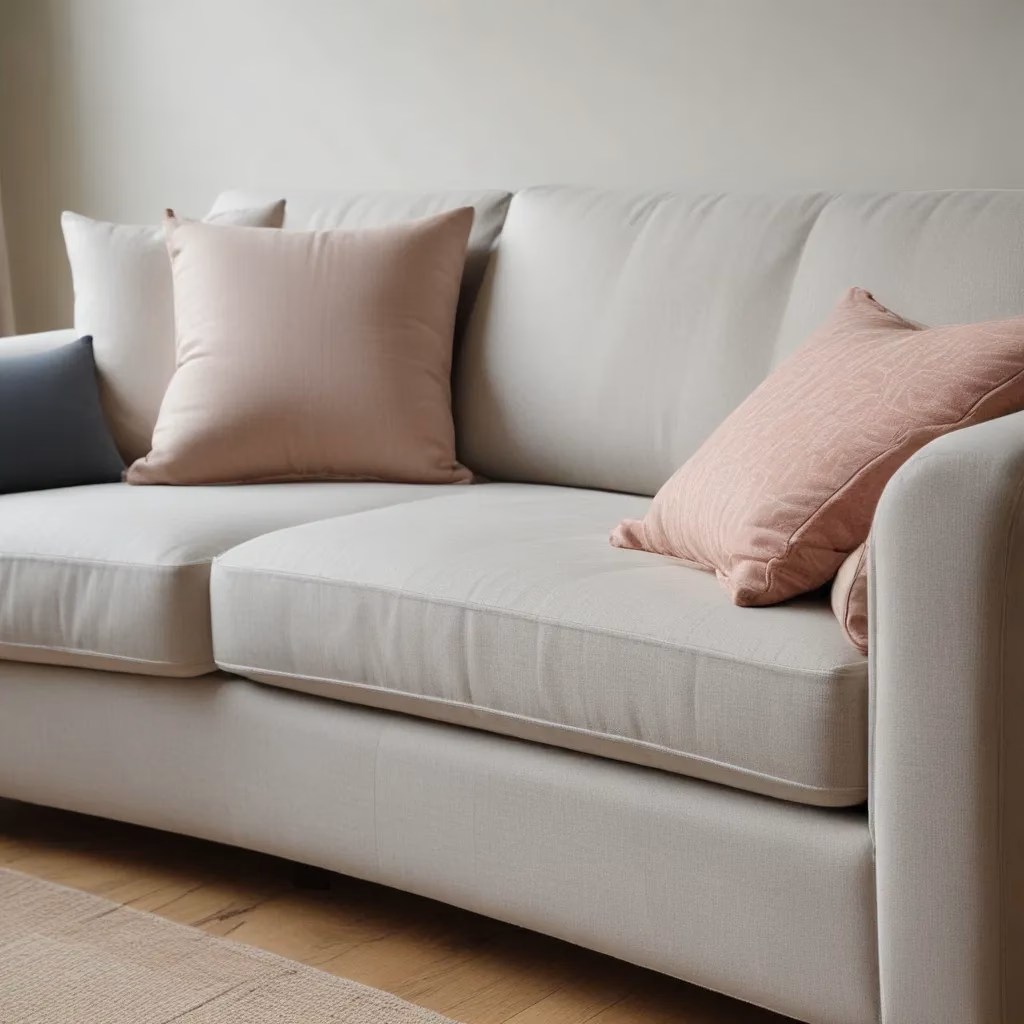
Sofa Placement 101: Arranging Your Living Room for Comfort and Flow
Creating the perfect living room arrangement starts and ends with your sofa. As the central piece of furniture, your sofa sets the tone for the entire space — both in terms of comfort and aesthetics. Whether you’re furnishing a new home or refreshing an existing space, thoughtful sofa placement is essential for maximizing the flow and functionality of your living area.
Now, this might seem counterintuitive…
Fabric and Upholstery Options
The journey begins with selecting the right sofa for your needs. With countless fabric, color, and silhouette choices on the market, it’s crucial to prioritize both form and function. Durable, easy-to-clean upholstery fabrics like microfiber, leather, or performance velvet can withstand the wear and tear of everyday use, while still elevating the overall style.
For a timeless, sophisticated look, consider a classic tufted or rolled-arm sofa in a neutral palette like beige, grey, or navy. These versatile styles pair well with a variety of design aesthetics, from farmhouse to mid-century modern. Alternatively, vibrant patterned or textured fabrics can inject personality and visual interest into a space. Just be mindful of how the sofa’s scale and proportions will balance with the room’s dimensions.
Sofa Sizing and Dimensions
Selecting the appropriate sofa size is crucial for both comfort and flow. Measure your living room carefully, taking into account doorways, walkways, and any existing furniture. As a general rule, your sofa should be no more than two-thirds the width of the wall it’s placed against. This allows for proper traffic circulation around the seating area.
For smaller spaces, a loveseat or chaise lounge may be a better fit than a full-size sofa. Conversely, expansive living rooms can accommodate larger sectional or modular designs that provide ample seating. Just be sure to leave at least 18 inches of space between the front of the sofa and the coffee table to prevent cramped legroom.
Evaluating Sofa Comfort
Beyond aesthetics, the true test of a great sofa lies in its comfort. Pay close attention to the cushion fill, back support, and overall ergonomics. High-quality memory foam or down-filled cushions will maintain their shape and plushness over time, while providing optimal lower back support. Opt for a sofa with a sprung or kiln-dried hardwood frame for long-lasting durability.
When visiting showrooms, make a point to actually sit on the sofa for several minutes. Evaluate how the height, depth, and angle of the seat and back feel, and whether your legs have sufficient support. Don’t be afraid to try out different configurations, such as a chaise sectional or recliner, to find your perfect fit.
Furniture Arrangement Principles
With your sofa selected, it’s time to consider the overall layout of the living room. Proper furniture placement is essential for creating a welcoming, functional space. Begin by identifying the room’s focal point — whether it’s a fireplace, entertainment system, or architectural feature — and arrange the seating to highlight this element.
Avoid clustering all the heavy furniture on one side of the room, which can create an unbalanced, lopsided appearance. Instead, aim for a symmetrical or asymmetrical design that incorporates a mix of larger and smaller pieces. Pair your sofa with complementary armchairs, ottomans, or loveseats to foster a natural conversation area.
Balancing Form and Function
While aesthetics are important, the living room might want to also accommodate everyday activities and traffic flow. Leave ample walking space (at least 3 feet) between seating arrangements and coffee tables or ottomans. This allows guests to easily navigate the room without feeling cramped or obstructed.
Additionally, consider the placement of lighting, side tables, and other accessories. Arrange these pieces within easy reach of the sofa, but not in a way that disrupts the room’s overall balance and proportion. The goal is to create a visually appealing yet highly practical layout that caters to your household’s needs.
Maximizing Space Efficiency
In smaller living rooms, strategic furniture placement is key to maximizing every square foot. Opt for multi-functional pieces like storage ottomans or modular sectionals that provide both seating and concealed storage. Floating or wall-mounted shelves can also help free up floor space while still offering display and organization opportunities.
When arranging the room, resist the urge to simply push the sofa against the wall. Instead, float it a few inches out from the wall to create a more dynamic, conversational layout. This simple adjustment can make the space feel larger and more inviting. Complementary armchairs or accent chairs can then be positioned around the sofa to complete the seating arrangement.
Upholstery Care Techniques
Maintaining the pristine condition of your sofa is essential for preserving its comfort and style over time. Establish a regular cleaning routine, using the manufacturer’s recommended upholstery care products and techniques. Gently vacuum the fabric to remove surface dirt and debris, and spot-clean any spills or stains immediately using a mild, water-based cleaner.
For deeper, more thorough cleanings, consider hiring a professional upholstery cleaning service every 12-18 months. These experts have the specialized equipment and expertise to safely refresh your sofa without damaging the fabric or underlying materials.
Maintaining Sofa Condition
Beyond regular cleaning, there are several steps you can take to extend the lifespan of your sofa. Rotate and flip the cushions periodically to double-check that even wear and prevent indentations. If your sofa has removable cushion covers, wash them regularly according to the care instructions.
For leather or performance-fabric sofas, consider applying a protective conditioning treatment every few months. This helps preserve the material’s supple texture and resistance to fading, staining, and cracking. Plump up throw pillows and fluff seat cushions after each use to maintain their shape and support.
Addressing Common Issues
No matter how well-built or cared for, every sofa will eventually show signs of wear and tear. Fortunately, many common issues can be addressed with a little DIY know-how. Tighten any loose hardware, repair tears or rips in the upholstery, and replace worn-out cushions as needed.
For more extensive damage, such as sagging springs or broken frames, it may be time to explore professional reupholstery or sofa replacement options. Look for reputable local furniture repair services that can breathe new life into your cherished seating piece.
Accessorizing the Living Room
Elevate the comfort and style of your living room with thoughtful accessorizing. Plush throw pillows, cozy blankets, and decorative accents can transform your sofa into an inviting focal point. Choose complementary colors, patterns, and textures that enhance the room’s overall aesthetic.
Strategically placed floor lamps, table lamps, and pendant lighting can also contribute to the ambiance, ensuring your living space is well-illuminated for both practical and aesthetic purposes. Consider dimmers or smart lighting controls for enhanced versatility and mood-setting capabilities.
Layering Textures and Patterns
Don’t be afraid to mix and match different materials and patterns to create visual interest. A blend of smooth, velvet, and woven textiles can add depth and dimension to your sofa and living room decor. Experiment with geometric prints, florals, or subtle striped patterns to complement the solid upholstery.
For a cohesive look, establish a color palette that ties the various elements together. Incorporate accents in shades that complement or contrast with your sofa, such as jewel-toned throw pillows or a vibrant area rug. The key is to strike a balance between cohesion and variety, resulting in a visually striking yet harmonious living space.
Identifying Quality Construction
When shopping for a new sofa, look for signs of sturdy, long-lasting craftsmanship. High-quality frames, joints, and springs are essential for maintaining structural integrity and comfort over time. Kiln-dried hardwood frames and eight-way hand-tied spring systems are hallmarks of superior construction.
Inspect the upholstery stitching, cushion fillings, and overall attention to detail. Avoid sofas with visible gaps, uneven seams, or low-density foam that may quickly lose its shape. Reputable brands and retailers can provide detailed information about the materials and manufacturing processes used in their products.
Budgeting and Cost Considerations
Sofa prices can vary significantly, from affordable mass-produced options to high-end, custom-made designs. When establishing your budget, consider not only the initial cost but also the long-term value and durability of the piece. Investing in a well-built, timeless sofa may be more expensive upfront, but can ultimately save you money by lasting for years or even decades.
Be wary of deeply discounted sofas that may sacrifice quality for the sake of a low price tag. Research the materials, construction, and reviews to double-check that you’re getting a worthy investment. Explore financing options, sales, and promotional offers that can help stretch your budget without compromising on the sofa of your dreams.
Contemporary Design Styles
As trends and preferences evolve, the sofa market continues to innovate, offering a diverse array of contemporary design styles to choose from. Mid-century modern sofas with clean lines, tapered legs, and minimalist silhouettes remain a popular choice for those seeking a sleek, retro-inspired look.
Alternatively, modular and sectional sofas provide unparalleled flexibility, allowing you to customize the configuration to suit your living space and entertainment needs. Oversized, low-profile designs with plush, deep seating cater to those who prioritize maximum comfort and relaxation.
Sustainable and Eco-Friendly Options
Increasingly, conscious consumers are seeking out sustainable and eco-friendly sofa options that align with their values. Look for sofas made from responsibly sourced, renewable materials like organic cotton, recycled polyester, or FSC-certified wood. Some manufacturers also offer take-back programs that allow you to recycle or responsibly dispose of your old sofa when it’s time for an upgrade.
Beyond the materials, consider the environmental impact of the sofa’s production and transportation. Opt for local or domestic brands that minimize their carbon footprint, and inquire about their manufacturing processes and energy-efficient practices.
Technology-Integrated Sofas
As smart home technology continues to evolve, the sofa is no exception. Cutting-edge designs now incorporate innovative features like built-in USB charging ports, wireless device charging, and even Bluetooth-enabled sound systems. These tech-forward sofas seamlessly blend function and style, catering to the needs of modern, tech-savvy households.
Some models also offer adjustable or reclining features, motorized headrests, and massage capabilities, delivering a truly customized comfort experience. While these high-tech sofas may carry a higher price tag, they can elevate your living room into a true smart home hub.
Furniture Placement Strategies
When arranging your living room furniture, start by positioning the sofa in a way that maximizes comfort and flow. As the central seating piece, the sofa should be placed to highlight the room’s focal point, whether it’s a fireplace, entertainment system, or architectural feature.
Avoid clustering all the heavy furniture on one side of the room, as this can create an unbalanced, lopsided appearance. Instead, aim for a symmetrical or asymmetrical design that incorporates a mix of larger and smaller pieces. Complement your sofa with armchairs, loveseats, or ottomans to foster a natural conversation area.
Zoning the Living Space
In open-concept living rooms, strategic furniture placement can help define distinct zones for different activities. Position the sofa to face the television or entertainment area, while grouping additional seating arrangements around secondary focal points, such as a reading nook or conversation area.
Consider using area rugs, lighting, and other design elements to visually delineate these zones and create a sense of flow throughout the space. Flexible, multi-functional pieces like storage ottomans or modular sectionals can also help maximize the functionality of your living room.
Optimizing Traffic Patterns
double-check that your living room layout promotes easy navigation and flow by leaving ample walking space (at least 3 feet) between seating arrangements and coffee tables or ottomans. This allows guests to move through the room without feeling cramped or obstructed.
Additionally, position lighting, side tables, and other accessories within easy reach of the sofa, but not in a way that disrupts the overall balance and proportion of the space. The goal is to create a visually appealing yet highly practical layout that caters to your household’s needs.
DIY Sofa Makeovers
If your existing sofa is in good structural condition but could use a style refresh, consider a DIY makeover. Swapping out the upholstery with a vibrant new fabric or slip cover can instantly transform the look and feel of your living room. For a more budget-friendly option, update the throw pillows, blankets, and other accent pieces to complement the sofa’s updated aesthetic.
Dive even deeper by exploring DIY reupholstery techniques or adding decorative elements like tufting, nailhead trim, or fringe. These personalized touches can breathe new life into a beloved piece and make it truly your own.
Integrating Sentimental Pieces
When arranging your living room, don’t be afraid to incorporate cherished, sentimental pieces that hold personal meaning. Whether it’s a vintage armchair passed down through generations or a contemporary sofa that reminds you of your first apartment, these types of furnishings can add character and warmth to the space.
Strategically placed within the broader furniture layout, these special pieces can become the focal point that ties the entire room together. Mix and match styles, eras, and materials to create a cohesive, yet eclectic, living room design that reflects your unique personality and experiences.
Crafting the perfect living room arrangement is an art form that balances form, function, and personal style. By carefully selecting a high-quality sofa, arranging your furnishings for optimal flow and comfort, and incorporating thoughtful accents and accessories, you can transform your house into a welcoming, stylish home. With these principles in mind, you’re well on your way to creating a living room that meets all your needs — whether you’re hosting a Super Bowl party or simply curling up for a cozy movie night.
Example: Limited-Edition Velvet Sofa Collection 2025



